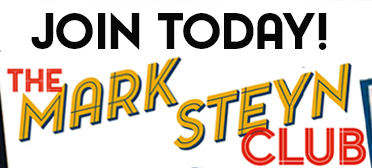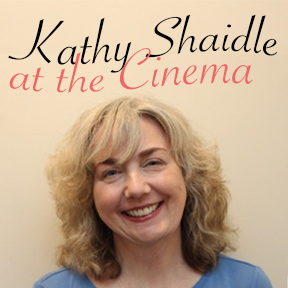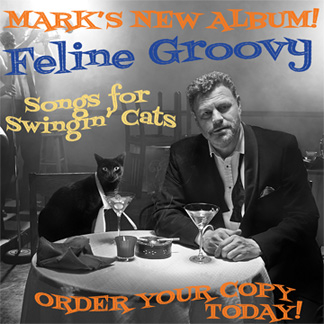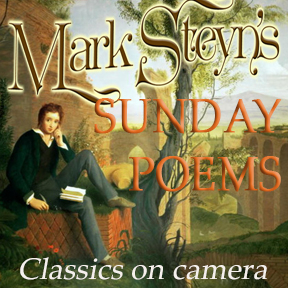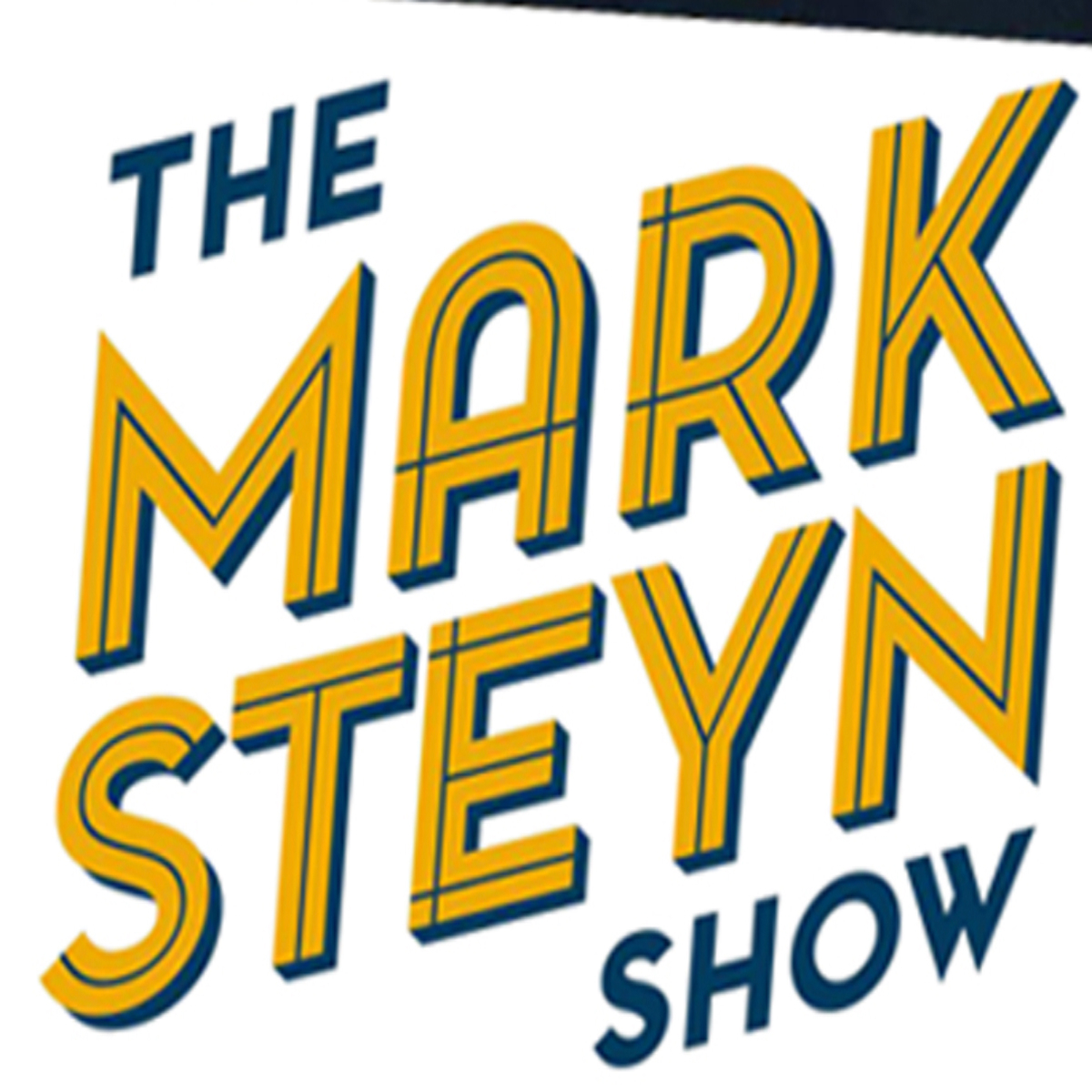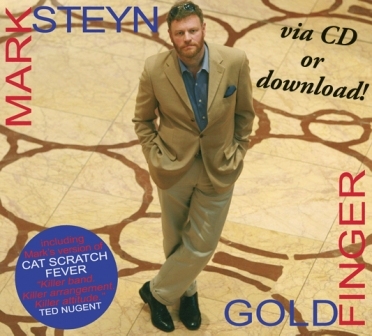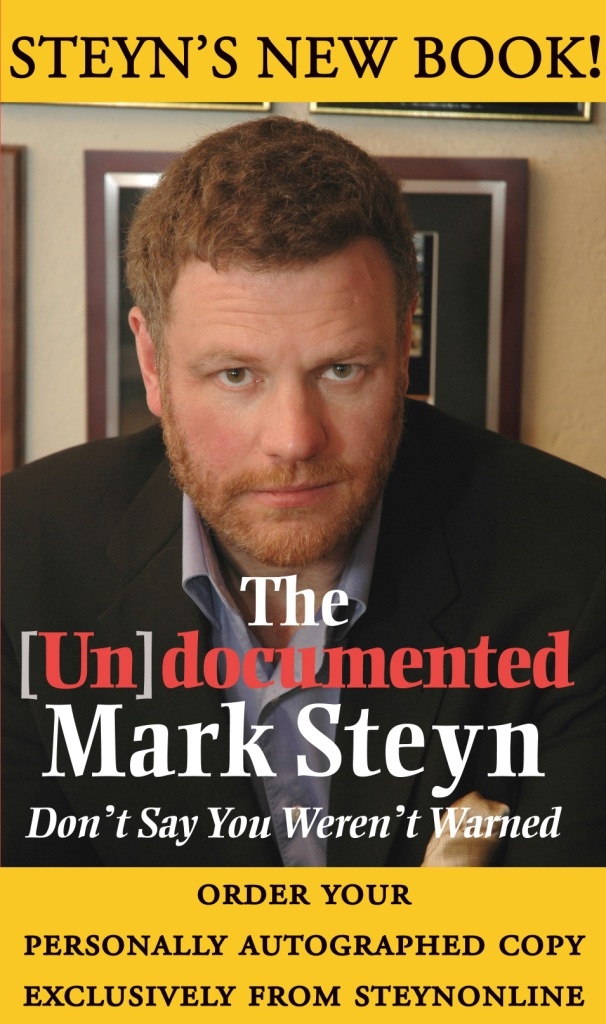 Someday someone should release an album called Classical Frank. I mentioned a couple of days ago that "Take My Love" was adapted from Brahms' Third Symphony. Aside from Brahms (whose Lullaby he also recorded), Sinatra sang over the years Anton Rubinstein, Grieg, Rachmaninov, Ravel and Borodin. That's to say, "If You Are But A Dream" (Rubinstein's Romance No 1), "I Love You" and "Strange Music" (Grieg's "Ich Liebe Dich" and "Wedding Day At Troldhaugen", respectively), "Full Moon And Empty Arms" and "I Think Of You" (both from Rachmaninov's Second Piano Concerto), "The Lamp Is Low" (Ravel's Pavane pour une infante défunte)... oh, and Borodin? Well, "Baubles, Bangles And Beads" is adapted from his String Quartet in D, and Sinatra recorded it in both in a swingin' non-String Quartet-ish Billy May arrangement, and as a bossa nova with Antonio Carlos Jobim.
Someday someone should release an album called Classical Frank. I mentioned a couple of days ago that "Take My Love" was adapted from Brahms' Third Symphony. Aside from Brahms (whose Lullaby he also recorded), Sinatra sang over the years Anton Rubinstein, Grieg, Rachmaninov, Ravel and Borodin. That's to say, "If You Are But A Dream" (Rubinstein's Romance No 1), "I Love You" and "Strange Music" (Grieg's "Ich Liebe Dich" and "Wedding Day At Troldhaugen", respectively), "Full Moon And Empty Arms" and "I Think Of You" (both from Rachmaninov's Second Piano Concerto), "The Lamp Is Low" (Ravel's Pavane pour une infante défunte)... oh, and Borodin? Well, "Baubles, Bangles And Beads" is adapted from his String Quartet in D, and Sinatra recorded it in both in a swingin' non-String Quartet-ish Billy May arrangement, and as a bossa nova with Antonio Carlos Jobim.
But among the longhairs Tchaikovsky can claim the crown - in the Sinatra oeuvre, he's the Sammy Cahn of the classical fellows, Frank's go-to guy when he wanted something with a whiff of the conservatory. In August 1939, with the Harry James band at the Roseland Ballroom in New York, he sang "Moon Love" (adapted from the gorgeous second movement of Tchaikovsky's Fifth Symphony from 1888), and in 1965 reprised it in a peerless Nelson Riddle arrangement. In 1941, with the Tommy Dorsey Orchestra, he sang "The Things I Love" (based on Tchaikovsky's Souvenir d'un lieu cher for violin and piano from 1878). At least thrice throughout the Forties, he recorded Axel Stordahl's arrangement of "None But The Lonely Heart" (the last of Tchaikovsky's Six Romances from 1869), and then revisited it with a Gordon Jenkins chart at the end of the Fifties.
But before any of those came today's song - which is in fact the very first studio recording of Frank's six-decade career: He came in singing Tchaikovsky.
Our story begins in 1939. Well, actually, it begins in 1869. That's when Tchaikovsky's fellow composer Balakirev proposed Shakespeare's Romeo and Juliet as a subject to young Pyotr Ilyitch. The resulting "fantasy-overture" uses the Bard's characters and themes for a series of musical contrasts, starting with the reflective clarinet-and-bassoon melody representing the star-crossed lovers' pal Friar Laurence, next a stormy passage for the feudin' an' a-fightin' Montagues and Capulets, and then the famous soaring love theme. Even today, in an illiterate and unmusical age, it remains one of the best known classical tunes, a mainstay of film and telly, where it functions as a reliable if invariably parodic shorthand for romantic passion: you'll hear it as the waves come rolling in on the beach, or the headboard shatters.
In the Thirties there was a modest vogue for big band arrangements of the classics. Larry Clinton and his orchestra had had a Number One hit in 1938 with "My Reverie" (based on Debussy) and he was looking for a follow-up. He found it in the big love theme from Romeo And Juliet, and set to work with the pianist Robert Emmerich and the lyricst Buddy Bernier (best known for "Poinciana"). And so that big lush Tchaikovsky melody became:
Our Love
I feel it everywhere
Through the night-time
It is the message of
The breezeOur Love
Is like an evening prayer
I can hear it
In every whisper of
The trees...
Clinton, Emmerich and Bernier ran out of Tchaikovsky at that point so were obliged to cook up a somewhat non-Tchaik middle section:
And so you're always near to me
Wherever you may be...
And then back to the main theme - a lovely, lyrical, flowing melody with an appealing harmony moving through the circle of fifths. Whether Tchaikovsky would have approved or not, his Romeo and Juliet theme turned out to be a song in waiting.
Around the time Pyotr Ilyich was getting the Buddy Bernier treatment, Francis Albert Sinatra and Nancy Rose Barbato of Hoboken were making plans for their wedding. Unlike Romeo and Juliet, they weren't star-crossed lovers. In contrast to the Montagues and Capulets, the Sinatras and Barbatos were both in favor of Master Francis and Miss Nancy tying the knot, Frankie's parents mainly because they figured it would settle him down. Young Sinatra had been arrested on November 26th 1938 on a morals charge:
On the second and ninth days of November, 1938, under the promise of marriage, Frank Sinatra had a sexual relationship with a single female of good repute named Antoinette Della Penta.
When it was brought to the attention of the "single female of good repute" that she was, in fact, a married female called Mrs Francke, she was still of sufficiently good repute that her amended charge against Sinatra of "adultery" was taken seriously. On January 24th 1939, the complaint was dismissed. A furious Nancy demanded to know, "Was she the first?" "No," said Frank. "But she's the last." Eleven days later, at the Church of Our Lady of Sorrows in Jersey City, Miss Nancy Barbato became Mrs Frank Sinatra.
For many years it was thought that somewhere between January 24th and February 4th Frank had gone into the studio and recorded a demo disc of "Our Love" as some kind of combined wedding gift for Nancy and penance for Mrs Francke, and that the session had perhaps been underwritten by his parents or maybe even Nancy's parents. In his authoritative 1995 book Sinatra! The Song Is You, Will Friedwald characterizes the recording date as such:
The circumstances surrounding this recording are vague, to say the least. Although the session was presumably underwritten by the Sinatra or Barbato family coffers, Sinatra is accompanied by a large-sounding orchestra with a full contingent of strings. It seems a tad on the expensive side for such a home-grown project. The conducting for the orchestra has been credited to one Frank Mann, who might have been a local leader or musician's contractor.
I first heard "Our Love" in the early 1990s, and that explanation never sounded quite right to me - not least because it's unclear to me how in late January anyone would know of the song. It turns out that the session took place on March 18th, and the conductor was not the mysterious Frank Mann but a fellow called Frank Mane, an alto sax player picking up freelance gigs where he could.
The two Franks met at WAAT, a radio station in Jersey City that featured live musicians in performance at their studios. Frank (Sinatra) liked to hang out there in hopes of landing some work, and Frank (Mane) would sometimes give him a ride home, or over to Nancy's place on Audubon Avenue. Frank and Frank took to having the occasional drink in nearby Bayonne, at the Sicilian Club, where musicians gathered to pass the word on who was hiring.
Mane was an odd chap. He loved music but he was entirely without showbiz ambition. He'd got together a band, and he'd booked a recording session with them - not because he wanted to have a big hit record but just because he wanted to hear for himself how his arrangements sounded on disc. The night before the session, Sinatra dropped by the Sicilian Club and heard Mane and his players rehearsing in the back room. "Mind if I come along tomorrow?" Frank S asked Frank M. Sure, said the bandleader.
And so on March 18th 1939 Frank Sinatra walked into a recording studio for the first time: It was Harry Smith's studio at 2 West 46th Street in Manhattan, an unassuming room but one in which the past and the future, the public and private Sinatras were all present. The drummer that day was Don Rigney, who had been best man at Frank and Nancy's wedding six weeks earlier. Among the reed players was Harry Shuckman, who would later be heard on many of Sinatra's records at Columbia.
The band played three instrumentals - "The Flight of the Bumblebee", Frank Mane's own "Eclipse", and "Girl Of My Dreams". Sinatra could feel the time, and his opportunity, slipping away. He went up and asked Mane: "May I sing?"
The bandleader checked the time - they had a few minutes left on the clock - and told him to pick a song from the handful of stock arrangements the publishers sent out to promote their new material. He made his choice and took his place at the microphone. And then, for the first time in any recording studio anywhere, Frank Sinatra started to sing:
It's a remarkably assured performance, even more so when one considers it's a brand new song. In a commonplace medium-slow foxtrot treatment, you can nevertheless hear pre-echoes of Sinatra's Tommy Dorsey ballads from a year or two later - the legato phrasing, his ability to float smoothly across the orchestra, even when (as here) the orchestra isn't up to his level... The only thing he might have done differently as a seasoned professional is the trick he learned from Dorsey's trombone, of connecting up the middle-eight and the return to the main theme without a breath:
And so you're always near to me
Wherever you may beI see
Your face in stars above
As I dream on
In all the magic of
Our Love!
From a first-timer, that last note is quite something.
But, as impressive as the content is, so too is the form. When the composer (okay, the adaptor) made his own record of "Our Love", it was the same length as the Sinatra/Mane record - just shy of four-and-a-half minutes. It seems likely that Frank Mane was working off a scaled-down chart of Larry Clinton's own arrangement. But Clinton's record is a conventional 1930s dance-band format: The band handle the first chorus, the vocalist comes in for the second, then the band play it out. Sinatra, whether at Mane's invitation or his own insistence, reverses the format: He takes the first chorus, the band plays the second chorus, and then he returns for a vocal outro. It prefigures the world to come: The age of the singer. Mane and Sinatra's "Our Love" is a vocal record with instrumental break. Larry Clinton and Bea Wain's is an instrumental record with vocal break. Bea Wain is one of my favorite big-band canaries, but I couldn't honestly say she has anything to teach Sinatra in her performance.
Even starker is another contrast. Three days before the two Franks went into Harry Smith's studio, Sinatra's future employer Tommy Dorsey was making his own record of "Our Love". He takes it at a faster clip than Frank Mane, but it's an arrangement by soon-to-be Sinatra sidekick Axel Stordahl, even if the tempo doesn't exactly assist vocal expressiveness. Yet Jack Leonard, Sinatra's predecessor as Dorsey vocalist and a man with several hit records to his name, sounds stiffer, choppier and far less sincere in his one perfunctory chorus.
Nevertheless, that Dorsey record got to Number One - while Frank Mane never released "Our Love". And, unlike "Moon Love" and "None But The Lonely Heart", Frank never returned to "Our Love" in his maturity. Even so, there is a second Sinatra recording of the tune - by Frank's second cousin, the bandleader Ray Sinatra, with vocal by Mary Martin (mother of Larry Hagman, if anyone ever asks you what's the connection between Tchaikovsky and "Dallas").
There were one or maybe two pressings made from that 1939 session at Harry Smith's studio. Sinatra, it seems, never got one. Mane kept his copy in a drawer for over half a century. But, four decades after that historic recording session, he briefly took it out and made a cassette for his one-night-only vocalist. In March 1980 Sinatra wrote back:
Dear Frank and Mary,
Belatedly but most appreciatively, I want to thank you so much for the wonderful tape. I have been on the road for the past several months, and am just now getting caught up on my mail. The tape brought back many fond memories. It was wonderful seeing you, too.
Warm regards,
Francis
Frank Mane was older than Sinatra but he outlived him by seven months, dying in December 1998 at the age of 94. According to his widow, "Our Love" might have been released on some or other boxed set, but the Manes and the Sinatras could never agree on the royalty split. Somehow a copy leaked out into the world, and in Europe, where copyright in recordings last 50 years, it wound up on a French CD and eventually, as you can see above, on YouTube. Sinatra biographer Anthony Summers tracked down Mrs Mane, and persuaded her to fish the original disc out of the safe in which she was now keeping it:
Its tattered adhesive label, typed with an old manual machine, shows the recording was made at Harry Smith Studios, "electrically recorded" for bandleader Frank Mane. Marked "#1 Orig.," it is the very first known studio recording of the thousand and more that were to make that skinny young man the most celebrated popular singer in history. For, under "Vocal chor. by," it bears the immaculately handwritten legend:
Frank Sinatra
"I've Got You Under My Skin", "The Lady Is A Tramp", "Come Fly With Me", Tommy Dorsey, Count Basie, Antonio Carlos Jobim, all lay ahead. But this is where it began: Number 2, West 46th Street, March 18th 1939, with Frank Mane, Tchaikovsky and "Our Love".
~Mark's beloved book A Song For The Season includes his essays on "My Funny Valentine", "Easter Parade", "Autumn Leaves" and other Sinatra songs. It's finally out in eBook - at Amazon, Barnes & Noble, Indigo-Chapters in Canada, and worldwide. So, whatever your preferred digital distribution method, you can be reading it within a minute!
Steyn's original 1998 obituary of Sinatra, "The Voice", appears in the anthology Mark Steyn From Head To Toe. There's more Sinatra songs in Mark Steyn's American Songbook. Personally autographed copies of both books are exclusively available from the Steyn store.
~For an alternative Sinatra Hot 100, the Pundette has launched her own Frank countdown. She's up to Number 74, wherein the Chairman of the Board makes a pizza. Bob Belvedere over at The Camp Of The Saints is also counting down his Top 100 Sinatra tracks, and has reached Number 65, Johnny Mandel's arrangement of what I've always regarded as a bit of a sub-par Irving Berlin song, "Be Careful, It's My Heart".
SINATRA CENTURY
at SteynOnline
6) THE ONE I LOVE (BELONGS TO SOMEBODY ELSE)
8) STARDUST
10) WHAT IS THIS THING CALLED LOVE?
11) CHICAGO
12) THE CONTINENTAL
13) ALL OF ME
15) NIGHT AND DAY
16) I WON'T DANCE
17) I'VE GOT YOU UNDER MY SKIN
19) EAST OF THE SUN (AND WEST OF THE MOON)




